The Laotian Civil War was a military conflict that pitted the guerrilla forces of the Marxist-oriented Pathet Lao against the armed and security forces of the Kingdom of Laos (French: Royaume du Laos), led by the conservative Royal Lao Government, between 1960 and 1975. Main combatants comprised:
- The Royal Lao Armed Forces (French: Forces Armées du Royaume), best known by its French acronym FAR, were the official armed defense forces of the Kingdom of Laos from 1959 to 1975. Subordinated to the Ministry of Defense of the Royal Lao Government at the capital Vientiane, the FAR branches were organized as follows:
- Royal Lao Army (French: Armée Royale du Laos – ARL)
- Royal Lao Air Force (French: Aviation Royale Laotiènne – AVRL)
- Royal Lao Navy (French: Marine Royale Laotiènne – MRL)
- Paramilitary security forces:
- Royal Lao Police (French: Police Royale Laotiènne – PRL)
- Directorate of National Coordination (DNC) Security Agency; a.k.a. Border Police (French: Police de Frontiers), active from 1960 to 1965.
To meet the threat represented by the Pathet Lao insurgency, the Laotian Armed Forces depended on a small French military training mission (French: Mission Militaire Française près du Gouvernment Royale du Laos – MMFI-GRL),[1] headed by a general officer, an exceptional arrangement permitted under the 1955 Geneva Accords, as well as covert assistance from the United States in the form of the Programs Evaluation Office (PEO), established on 15 December 1955, replaced in 1961 by the Military Assistance Advisory Group (Laos), which was later changed in September 1962 into the Requirements Office.[2] Between 1962 and 1971, the U.S. provided Laos with direct military assistance, but not including the cost of equipping and training irregular and paramilitary forces by the Central Intelligence Agency (CIA).[3] In addition to U.S. covert support, the FAR received further military assistance from the United Kingdom, Thailand, Burma, the Philippines, the Republic of China (Taiwan), South Vietnam, South Korea, Japan, Indonesia, and Australia;
- The Neutralist Armed Forces (French: Forces Armées Neutralistes – FAN), a dissident splinter faction of the FAR led by Captain (later, Major general) Kong Le, active from 1961 to 1966, which received support from North Vietnam, the Soviet Union, and Indonesia;[4]
- The irregular Anti-communist Special Guerrilla Units (SGU), also collectively referred to as the "Clandestine Army" or "Secret Army" (French: Armée Clandestine or Armée Secréte), recruited from Laos' ethnic minorities such as the Hmong (Meo), Yao (Iu-Mien), Mien, Lao Theung (Hune) and Lao Sung hill tribes, was led by Royal Lao Government Minister Touby Lyfoung, Major general Vang Pao and Brigadier general Thao Ty. Created from irregular ethnic auxiliary units (French: Suppletifs) raised earlier by the French during the First Indochina War, the SGUs were in reality secretly organized, trained and armed by the CIA since the late 1950s and early 1960s;[5]
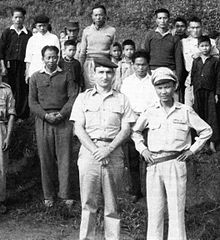
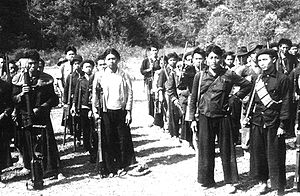
- The Pathet Lao, also known as the "Lao People's Party" (1955–1972) and later the "Lao People's Revolutionary Party" (1972–present) led by Prince Souphanouvong, and its military wing the Lao People's Armed Forces (LPAF), which was trained and armed by North Vietnam, the Soviet Union, and the People's Republic of China;

- The People's Army of Vietnam (PAVN), also designated the "North Vietnamese Army" (NVA), which received support from the Soviet Union, the People's Republic of China, North Korea, East Germany, Czechoslovakia, Poland, Hungary and Bulgaria.
An eclectic variety of weapons was used by all sides in the Laotian Civil War. Laotian regular FAR and FAN and irregular SGUs weaponry in the early days of the war was a hodgepodge, with most of their combat units equipped in a haphazard way with an array of French, American, Australian, British, and German weapon systems, mostly of WWII-vintage, either drawn from First Indochina War stocks handed down by the French or secretly provided by the Americans.[6][7] After 1955 however, the FAR began the process of standardisation on U.S. equipment, with its airborne and infantry units first taking delivery of semi-automatic and automatic small-arms of WWII/Korean War-vintage in late 1959, followed by the delivery between 1963 and 1971 of more modern military equipments, which included aircraft, armored and transport vehicles, and long-range artillery pieces. In 1969 secret deliveries of modern U.S. small-arms arrived in Laos, and were initially only given to the Laotian Royal Guard and airborne units; standardisation in U.S. fully-automatic infantry weapons in the RLA and the irregular SGUs was completed by 1971, replacing much of the older weaponry.[8][9] Captured infantry weapons of Soviet and Chinese origin were also employed by elite commando or airborne units and the irregular SGUs while on special operations in the enemy-held areas of north-eastern and south-eastern Laos.[10][11]
During the early phase of the war, the Pathet Lao likewise was largely equipped with WWII-vintage French, Japanese, American, British, German, Chinese, and Czechoslovakian weapons either pilfered from French colonial forces during the First Indochina War, seized from Laotian FAR units or provided by the Vietminh and subsequently by North Vietnam. As the war progressed, these obsolete weapons began to be partially superseded by more modern Eastern Bloc military hardware, including semiautomatic and fully automatic small-arms, artillery pieces, armored and transport vehicles, and aircraft of Soviet, Chinese and Hungarian origin, mostly being channelled via the North Vietnamese. Although the Pathet Lao standardized on Soviet and Chinese weapons and equipment by the early 1970s, its guerrilla forces continued to make use of captured enemy stocks until the end of the war.
Royal Lao Armed Forces, FAN and SGUs Equipment
Revolvers
Received from the U.S. Government, used by government officials and military officers.[12]

Pistols

- MAS-35-S pistol (7.65mm Longue): Received from France during the First Indochina War.
- Luger P08 pistol: Received from France during the First Indochina War.[13]
- Walther P38: Received from France during the First Indochina War.[14]
- Colt.45 M1911A1
- Smith & Wesson Model 39
Submachine guns

- MAS-38: Received from France during the First Indochina War.
- MAT-49: Received from France during the First Indochina War.[15]
- Sterling submachine gun: Limited quantities handed down by Britain.
- Owen submachine gun[16]
- Sten submachine gun: Received from France during the First Indochina War.[17]
- Carl Gustaf m/45: used by Green Berets' advisors and CIA operatives.[18]
- M1A1 Thompson[19][20]
- M3/M3A1 Grease Gun: Used by the Royal Lao Police Aerial Reinforcement Unit.[12]
- PPSh-41: Captured.[21]
Bolt-action rifles

- MAS-36: Received from France during the First Indochina War.[22]
- M1903 Springfield: Limited quantities, received from France during the First Indochina War and the United States.[12]
- Lee–Enfield: Limited quantities, received from France during the First Indochina War.
Carbines

- M1 Carbine: M1 & M2 models were standard issue concurrent with the M1 Garand rifle before receiving the M16.[23]
- M1A1 Carbine[13]
- M2 Carbine: Full automatic variant.[24][25]
- CAR-15 Assault carbine
Battle rifles

- M1 Garand semi-automatic rifle
- SKS semi-automatic rifle: Captured.
- L1A1 SLR Assault rifle: Limited quantities handed down by Britain.
- M16A1 Assault rifle[8]
- AK-47: Captured.[26]
- Type 56 assault rifle: Captured.[26]
- AKM: Captured.[26]
Shotguns
Light machine guns

- FM 24/29: Received from France during the First Indochina War.
- Bren: Received from France during the First Indochina War.
- M1918A2 BAR[19]
- M1919A6 light machine gun
General-purpose machine guns
Heavy machine guns

- Browning M1919A4 .30 Cal[27]
- Browning M2HB .50 Cal
- SG-43/SGM Goryunov: Captured.
- DShKM: Captured.[28]
Grenade systems
- Alsetex OF37 grenade[25]
- F-1 hand grenade
- Mark 2 fragmentation hand/rifle grenade
- M26 grenade[24]
- M59 "Baseball" hand grenade[29]
- M61 fragmentation hand grenade
- M67 grenade
- M18 colored smoke hand grenade
Explosives
Land mine systems
- M2 bounding anti-personnel mine
- M18A1 Claymore anti-personnel mine
- M14 anti-personnel blast mine
- M16 bounding anti-personnel fragmentation mine
- M15 anti-tank mine
- M19 anti-tank mine
- M24 off-route anti-tank mine: limited use by MACV–SOG teams.[30]
Rocket systems
Anti-tank rockets

Grenade launchers

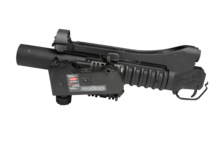
Recoilless rifles
- M18A1 57mm[34]
- M20 75mm[35]
- M67 90mm (shoulder-fired)
- M40A1 106mm
Mortars

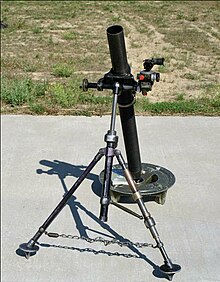

- M19 60mm mortar
- Brandt mle 27/31 81mm mortar: Received from France during the First Indochina War.
- M29 81mm mortar
- M2 4.2-inch (107mm) mortar
- M30 4.2 inch (106.7mm) mortar
Howitzers
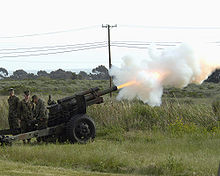


- M101A1 105mm towed field howitzer[36]
- M114A1 155mm towed field howitzer[36]
- M116 75mm towed field howitzer
Air defense guns
- M1939 (61-K) 37mm: Captured.[27]
Vehicles


- M24 Chaffee Light tank[37][38]
- PT-76 amphibious light tank: provided to the FAN by the Soviet Union or captured.[39][28][40]
- M8 HMC 75mm self-propelled howitzer
- M8 Greyhound armoured car[27][41]
- M3A1 Scout Car[27][41]
- M3 Half-track[42]
- M-706 armoured car[43][44][40][45]
- M113 armored personnel carrier[46][36]
- Willys MB ¼-ton (4x4) jeep
- Willys M38 MC ¼-ton (4x4) jeep
- Willys M38A1 MD ¼-ton (4x4) jeep[9]
- Jeepster Commando (4x4) hardtop Sport utility vehicle (SUV)
- M151A1 ¼-ton (4x4) utility truck[47]
- Dodge WC-51/52 ¾-ton (4x4) utility truck
- Dodge M37 ¾-ton (4x4) 1953 utility truck
- Chevrolet G506 1½-ton (4x4) cargo truck
- GMC CCKW 2½-ton (6x6) cargo truck
- M35A2 2½-ton (6x6) cargo truck[48][47]
- M809 5-ton (6x6) cargo truck[47]
Helicopters
- UH-1C Huey gunship[49]
- UH-1D/H transport[50]
- Mil Mi-4 transport: provided to the FAN by the Soviet Union.[51][52]
- Sikorsky H-19 transport
- Sikorsky H-34D transport[53][54][55][52]
- Sud Aviation SA 3130 Alouette II light helicopter[56][57]
- Sud Aviation SA 316B Alouette III light helicopter[56][52]
Aircraft

- Cessna T-41B/D Mescalero trainer[58][52]
- North American T-6G Texan trainer/fighter-bomber[12][52]
- North American RT-28B Trojan trainer[52][36]
- North American T-28D Trojan fighter-bomber[59][60][61][62][63][54][64][65]
- AC-47D Spooky gunship[66][54][55]
- De Havilland Canada DHC U-6 (L-20) Beaver STOL utility transport[12]
- De Havilland DH.104 Dove short-haul airliner
- Aero Commander 560 utility transport[52]
- Antonov An-2 utility aircraft: provided to the FAN by the Soviet Union.[52]
- Douglas C-47D Skytrain transport[67][54][55][68]
- Lisunov Li-2 utility transport: provided to the FAN by the Soviet Union.[51]
- Curtiss C-46F Commando transport[52][36]
- Fairchild C-123K Provider transport[69][70]
- Morane-Saulnier MS 500 Criquet liaison aircraft[71][72]
- U-17A/B light utility aircraft[69][73]
- Cessna L-19A/O-1F Bird Dog reconnaissance/observation light aircraft[74][54][52]
- EC-47D SIGINT aircraft[36]
River craft
- Cabin-type patrol boat[75]
- Chris-Craft patrol boat[76]
- 11m patrol boat[77]
- PBR, Patrol Boat River (all fiberglass boats, propelled by twin water jets)
- LCM-8 Landing Craft Utility (LCU)
Pathet Lao forces Equipment
Pistols
- Tokarev TT-33[78]
- Type 54 pistol: Chinese copy of the TT-33.
- Type 59 pistol: Chinese copy of the Makarov PM.[79]
- Colt.45 M1911A1: Captured.
Submachine guns
Carbines
- M1 Carbine: all variants captured.
- M1A1 Carbine
- M2 Carbine
Bolt-action rifles
- Mosin–Nagant: Received from the Soviet Union and North Vietnam.[54]
- Type 53 Carbine: Received from China and North Vietnam.[81]
- MAS-36: Captured.[22]
- Arisaka: Limited quantities handed down from North Vietnam.
- US M1917: Captured from the French during the First Indochina War or received from the Viet Minh.
- Mauser Kar98k: Mauser rifles received from China and the Soviet Union handed down by North Vietnam.[12]
Sniper rifles

- M/52[82]
- Dragunov SVD-63: limited use by the PAVN.[83]
Battle rifles
- SKS semi-automatic rifle[12]
- Type 56 Carbine: Chinese copy of the SKS.
- vz. 52 rifle
- AK-47[84][26]
- AKM[85][26]
- Type 56 assault rifle: Chinese variant of the AK-47.[26]
- Type 56-1[78][26]
- M1 Garand semi-automatic rifle: Captured.
- M16A1 Assault rifle: Captured.
Light machine guns

- Degtyaryov DP/DPM
- Type 53: Chinese copy of the Degtyaryov DP/DPM.
- RPK
- Type 26: Chinese copy of the ZB vz. 26.
- Bren: Captured.[20]
- FM 24/29: Captured.
- M1918A2 BAR: Captured.
General-purpose machine guns
- Degtyaryov RP-46[86]
- RPD
- Type 56 machine gun: Chinese copy of the RPD.
- PK/PKM
Heavy machine guns

- SG-43/SGM Goryunov[87]
- Type 53/57: Chinese variant of the SG-43/SGM.
- DShKM[28]
- Type 54: Chinese variant of the DShKM.
- KPV
- Browning M1919A4: Captured.[28]
Grenade systems
- F1/M33 hand grenade
- RG-4 anti-personnel grenade
- RG-42 hand grenade
- RGD-5 hand grenade[78]
- RPG-43 anti-tank grenade
- Type 1/M33 hand grenade
- Type 42 hand grenade
- Type 59 hand grenade
- Type 67 stick granade[88]
Land mine systems
- POMZ-2 anti-personnel mine
- Type 2M anti-personnel mine
- PMD-6/7 anti-personnel mine
- PP-Mi-Sr anti-personnel mine
- TMD-B anti-personnel mine
- TM-41 anti-tank mine
- TMB-2 anti-tank mine
- TM-46/TMN-46 anti-tank mine
Anti-tank rocket launchers

- RPG-2: B40 Rocket
- RPG-7: B41 Rocket[12]
- Type 56 RPG
- Type 69 RPG
Grenade launchers
- M79: Captured.
Recoilless rifles
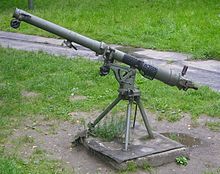
Mortars
- Brandt mle 27/31 81mm mortar: Captured.
- Type 53 82mm mortar
- PM-41 82mm mortar[87]
- M1938 107mm mortar[89]
- Type 55 120mm mortar
Howitzers

- M-30 122mm howitzer (M1938)
- D-30 2A18 122mm towed howitzer
- M-46 130mm towed field gun (M1954)
- M101A1 105mm towed field howitzer: Captured from the French; used by the PAVN earlier in the War.[90]
Air defense guns


- ZPU-1 14.5mm Single-barrelled AA autocannon
- ZPU-2 14.5mm Double-barrelled AA autocannon
- ZPU-4 14.5mm Quadruple-barrelled AA autocannon
- ZU-23-2 23mm twin automatic anti-aircraft gun[91]
- M1939 (61-K) 37mm air defense gun[27]
- AZP S-60 57mm air defense gun
Vehicles

- PT-76 amphibious light tank[28][40][92][36]
- T-34/85 medium tank[93][94]
- Type 62 light tank[36]
- T-54/55 main battle tank[95][96][97]
- BRDM-2 Amphibious Armoured Scout Car[36]
- BTR-40 armored personnel carrier[28][98][36]
- BTR-152 armored personnel carrier[99]
- BJ-212 (4x4) light Utility Vehicle[100]
- GAZ-69A (4x4) light truck[100]
- GAZ-51 (4×2) 2½-ton cargo truck
- GAZ-63 (4x4) 2-ton cargo truck[101]
- ZIL-130 medium-weight general-purpose truck
- ZIS-151 2½-ton (6x6) general-purpose truck
- ZIL-157 2½-ton (6x6) general-purpose truck
- M35A2 2½-ton (6x6) cargo truck: Captured.[102]
Helicopters
Aircraft
- Polikarpov Po-2 utility biplane/trainer
- Antonov An-2 utility aircraft[51]
- Lisunov Li-2 utility transport[51]
- Ilyushin Il-12 transport
River craft
- Dugout canoe
- River Sampan